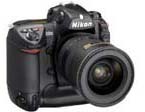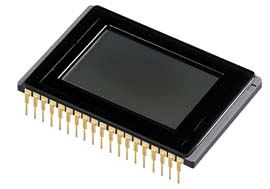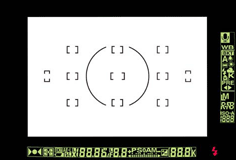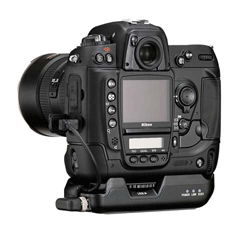|
Jul. 22. 2003 |
 |
 |
|
TOKYO -- Nikon Corporation is pleased to announce the
introduction of a professional digital SLR camera that delivers high
speed, high resolution, and improved handling for action photography: the
Nikon D2H. Since the launch of the D1 series and successful introduction of the Nikon DX Format in September 1999, Nikon has been conducting extensive research into the needs of photographers in every field and discipline. This research, coupled with painstaking analysis of feedback from Nikon users worldwide, has led to a string of technological and design innovations for the Nikon DX Format aimed at enhancing system performance for the serious photographer.
The D2H is the first digital SLR in the world capable of continuous shooting at 8 frames per second for up to 40 consecutive JPEG or 25 RAW (NEF [Nikon Electronic Image File]) full-resolution (2,464 x 1,632-pixel) images. Performance is further enhanced by the remarkably short 37ms shutter time lag -- currently the shortest for a Digital SLR -- making the D2H as responsive as the Nikon F5 professional film SLR. Instant power-up means the D2H is ready to shoot as soon as you are. Together, these high-speed functions give the photographer exceptional control over moving subjects and rapidly unfolding events.
The LBCAST imaging sensor also inherits the advantages of the DX Format, bringing together the right combination of high speed, image quality, power efficiency, and optical performance of the lens to realize total system performance. The format also maintains consistency of the angle of view across the Nikon DX Format SLR lineup. The sensor's thinner Optical Low Pass Filter (OLPF) moreover effectively suppresses moire patterns without compromising the camera's high resolution.
The D2H further incorporates image-processing technologies that raise Nikon's Total Image Quality to new heights. The camera's 3D Matrix Image Control delivers subtle color gradations and smooth diagonals, while minimizing the appearance of color fringes and reducing false colors. Thanks to three separate sensors, the D2H achieves highly refined Auto White Balance (AWB) and Auto Tone Control (ATC) under different light conditions. And thanks to Nikon's Color Reproduction System, photographers can also select from three optimized color modes. The result of these innovations is increased versatility, easy-to-use metering, and exceedingly faithful color reproduction with clean, crisp details -- for all subjects and workflow environments. Despite being a powerhouse of Nikon technologies, the D2H comes in a compact, lightweight, easy-to-handle magnesium alloy body that is tightly sealed to resist exposure to dust and water drops - and sturdy enough to withstand the rigors of globe-trotting photojournalism. Photographers will especially appreciate the large buttons and controls, all logically placed for smooth, intuitive handling. The design of the camera's ergonomic styling is adopted from one created by famed industrial designer Giorgetto GIUGIARO* exclusively for a new generation of Nikon camera.
The new optional Wireless Transmitter WT-1 interfaces directly with IEEE 802.11b compatible access points to realize wireless transfer of image and sound data to FTP servers, and mark a major advance in freeing the photographer's movement and in the ability to deliver timely photos promptly. The new Nikon Speedlight SB-800 forms the core of the new Creative Lighting System supported by the D2H to add new creative possibilities that are easy to use. The new i-TTL system supports Advanced Wireless Lighting and versatile functions for up to four groups of Speedlights, with 3 remote i-TTL speedlight groups controlled through the master SB-800. New features include advanced i-TTL flash control for optimum results from Auto Balanced Fill-Flash, Flash Value Lock (FV Lock), AUTO FP High-Speed Sync, and a Wide Area AF Assist Illuminator that is tailored to the new D2H's 11-area Multi-CAM 2000 AF Sensor Module. Nikon Capture 4 is a comprehensive image-editing and remote camera control software package that fully supports NEF (Nikon Electronic image File), TIFF and JPEG images from the D2H. Features of the new version include Image Dust Off sensor dust & particle shade removal control, Digital DEETM scene-specific automatic dodge and burn control, a transformation function that creates two varieties of ultra-wideangle image from those shot using the AF DX Fisheye-Nikkor 10.5mm f/2.8G ED, as well as improved batch processing. Note: Specifications, design, product name and standard accessories may differ by country or area. |
Nikon D2H Major Features:Unparalleled Speed and Response
*As of Jul. 2003. |
Breakthrough Image Sensing
|
Innovative Image Processing
|
Rugged, Functional Design
|
Convenient Data Transfer
*NEF images taken with the D2H are supported by Nikon Capture 4 only. |
Creativity and Versatility
|
Nikon D2H Specifications |
| Type of Camera | Lens-interchangeable digital SLR camera | ||||||||||||||||
| Effective Pixels | 4.1 million | ||||||||||||||||
| Image Sensor | JFET image sensor LBCAST, 23.3 x 15.5mm size, 4.26 million total pixels | ||||||||||||||||
| Recording Pixels | [L] 2,464 x 1,632-pixel / [M] 1,840 x 1,224-pixel | ||||||||||||||||
| Sensitivity | ISO equivalency 200 to 1,600 (variable in 1/2, 1/3, or 1EV
steps), Sensitivity can be extended by 1 or 2 steps beyond ISO 1,600 | ||||||||||||||||
| Storage System | NEF (12-bit RAW uncompressed or lossless
compression), Exif 2.2 file (uncompressed TIFF-RGB or compressed JPEG) | ||||||||||||||||
| Storage Media | CompactFlashTM (CF) Card (Type I / II) and MicrodriveTM | ||||||||||||||||
| Shooting Modes |
| ||||||||||||||||
| White Balance |
| ||||||||||||||||
| LCD Monitor | 2.5-in., 211,200-dot, low temp. polysilicon TFT LCD with white LED backlighting; Backlight/brightness adjustment available | ||||||||||||||||
| Playback Function | 1.) Full frame, 2.) Thumbnail (4 / 9 segments), 3.) One-touch zoom, 4.) Slideshow, 5.) Histogram indication, and Highlight point display | ||||||||||||||||
| Delete Function | 1.) Card format, 2.) All frames delete, 3.) Selected frames delete | ||||||||||||||||
| Video Output | NTSC or PAL (switchable) | ||||||||||||||||
| Interface | USB 2.0 (Hi-Speed) (Mini-B connector) FTP file transfer available with optional Wireless Transmitter WT-1 (IEEE 802.11b) | ||||||||||||||||
| Voice Memo | Record mode: Automatic or manual recording at shooting or
playback, Max. Recording time: 60 seconds Playback mode: Built-in speaker or Audio/Video cable File format: Mono WAV file | ||||||||||||||||
| Text Input | Up to 30 characters of alphanumeric text input is available with LCD monitor and multi-selector; stored in Exif header | ||||||||||||||||
| Usable Lenses |
| ||||||||||||||||
| Picture Angle | Approx. 1.5x focal length in 35mm [135] format equivalent | ||||||||||||||||
| Viewfinder | Optical-type fixed eye-level pentaprism; Built-in diopter adjustment (-3 to +1 m-1), Eyepiece shutter provided | ||||||||||||||||
| Eyepoint | 19.9mm (at -1.0 m-1) | ||||||||||||||||
| Focusing Screen | B-type BrightView Clear Matte Screen III; Interchangeable with optional Finder Screen E with grid | ||||||||||||||||
| Viewfinder Frame Coverage | Approx. 100% | ||||||||||||||||
| Viewfinder Magnification | Approx. 0.86x with 50mm f/1.4 lens set to infinity and -1.0 m-1 | ||||||||||||||||
| Reflex Mirror | Automatic, instant-return type | ||||||||||||||||
| Lens Aperture | Instant-return type, with depth-of-field preview button | ||||||||||||||||
| Autofocus | TTL phase detection, Nikon Multi-CAM2000 autofocus
module; Detection range: EV -1 to +19 (ISO 100 equivalent, at normal temperature) | ||||||||||||||||
| Lens Servo | 1.) Single Servo AF [S], 2.) Continuous Servo AF [C], 3.)
Manual focus [M] Focus Tracking automatically activated by subject's status in [S] or [C] AF | ||||||||||||||||
| Focus Area | Selectable from 11 focus areas | ||||||||||||||||
| AF Area Mode | 1.) Single Area AF, 2.) Dynamic AF with Focus Tracking and Lock-onTM, 3.) Closest Subject Priority Dynamic AF, 4.) Group Dynamic AF | ||||||||||||||||
| Focus Lock | Focus is locked by pressing AE/AF Lock button or lightly pressing shutter release button in [S] AF. | ||||||||||||||||
| Exposure Metering System | TTL full-aperture exposure metering system;
| ||||||||||||||||
| Exposure Metering Range |
| ||||||||||||||||
| Exposure Meter Coupling | CPU and AI (Automatic maximum aperture Indexing) | ||||||||||||||||
| Exposure Mode |
| ||||||||||||||||
| Exposure Compensation | Exposure compensated in +/- 5.0 EV range in 1/3, 1/2 or 1 EV steps | ||||||||||||||||
| Auto Exposure Lock | Detected exposure value locked by pressing AE-L/AF-L
button. Number of shots: 2 to 9 frames Compensation steps: 1/3, 1/2, 2/3, or 1EV steps | ||||||||||||||||
| Shutter | Electromagnetically controlled vertical-travel focal-plane
shutter, 30 to 1/8,000 s and bulb | ||||||||||||||||
| Sync Contact | X-contact only: flash synchronization up to 1/250 second | ||||||||||||||||
| Flash Control |
| ||||||||||||||||
| Flash Sync Mode | 1.) Front-Curtain Sync (normal sync), 2.) Red-Eye Reduction, 3.) Red-Eye Reduction with Slow Sync, 4.) Slow Sync, 5.) Rear-Curtain Sync | ||||||||||||||||
| Ready-light | Lights up when flash fully charged with Speedlight SB-800 / 80DX / 50DX / 30 / 28 / 27 / 22S; blinks for full output warning | ||||||||||||||||
| Accessory Shoe | ISO 518 standard-type hot shoe contact; Safety lock mechanism provided | ||||||||||||||||
| Sync Terminal | ISO 519 standard terminal, lock screw provided | ||||||||||||||||
| Self-timer | Electronically controlled; Timer duration: 2, 5, 10, and 20 seconds | ||||||||||||||||
| Depth-of-field Preview Button | Stop-down lens aperture by pressing depth-of-field preview button | ||||||||||||||||
| Remote Control | Via 10-pin remote terminal | ||||||||||||||||
| Power Requirements | Rechargeable Li-ion Battery EN-EL4 (11.1V DC), Quick Charger MH-21, AC Adapter EH-6 | ||||||||||||||||
| Tripod Socket | 1/4 in. (ISO1222) | ||||||||||||||||
| Battery Monitoring System | The LCD monitor on the camera back displays the following information about the EN-EL4 battery: 1.) Remaining charge (%); 2.) No. of shots taken since last charge; 3.) Calibration status (Recommended/Not required); 4.) Battery life (5 stages) | ||||||||||||||||
| Dimensions (W x H x D) | Approx. 157.5 x 149.5 x 85.5mm (6.2 x 5.9 x 3.4 in.) | ||||||||||||||||
| Weight (without battery) | Approx. 1,070g (2.4 lbs.) | ||||||||||||||||
| Supplied Accessories* | Rechargeable Li-ion Battery EN-EL4, Quick Charger MH-21,
Body Cap, Camera Strap AN-D2H, AV Cable EG-D2, USB Cable UC-E4, LCD
Monitor Cover BM-3, Nikon View Software CD-ROM | ||||||||||||||||
| Optional Accessories | Wireless Transmitter WT-1, Extended Range Antenna WA-E1,
AC Adaptor EH-6, Interchangeable Focusing Screen E, Antifog Finder Eyepiece DK-16A, Eyepiece Correction Lens DK-16C series, Speedlight SB-800 / 80DX / 50DX, Nikon Capture 4 software, CompactFlashTM card. | ||||||||||||||||
| *Supplied Accessories may differ in each country or
area CompactFlashTM is a trademark of SanDisk Corporation. Digital DEETM is a technology developed by Applied Science Fiction. Specifications and equipment are subject to change without any notice or obligation on the part of the manufacturer. Jul. 2003 |
|
|
| Presented by Nikon Corporation Imaging Company,
Tokyo, Japan. Copyright © 2003 Nikon Corporation. All rights reserved. |



